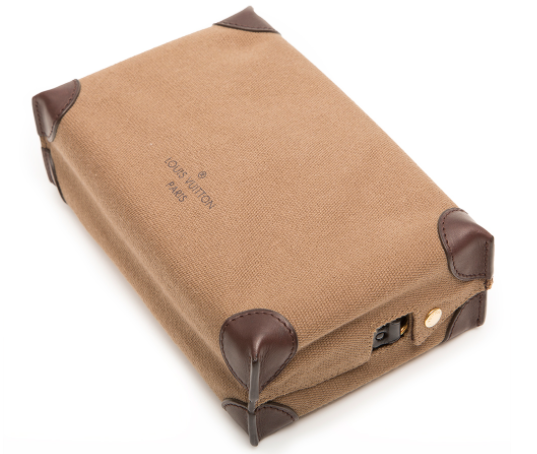The 'Petite Malle' (small trunk) by Louis Vuitton has got to be one of my favourite bags by LV.
Designed by Nicolas Ghesquière, this mini trunk is complex to build and fabulously expensive.
They have used their 160+ years of trunk making experience into crafting a small clutch case - with a few modern advancements.
I want to share with you some of the techniques that I have observed. Hopefully this will bring about some new ideas for designs and inspire you to try some of these out on your own projects.
But first, the case:
Overall dimensions are 4.4″ L x 7.9″ W x 2.2″ D

The construction of this bag starts with a wooden base or 'carcass' with which the exterior leather, coated canvas or exotic skin is glued on to.

Here you can see the wooden carcass frame which will be wrapped in LV's famous monogram coated canvas.
It appears that the exterior parts are stitched together prior to wrapping and riveting.
If you look closely to the edges of the plywood frame (above image), you can see scorch marks from being laser cut. The plywood appears to be around 3-4mm, so this makes a lot of sense and ensures accuracy while saving time.

In the example above, the craftsman is wrapping the wooden frame with what appears to be alligator skin.
The holes going through the skin and wooden carcass will be for rivets and strap attachments.
This appears to be the smallest 'Petite Malle' which opens from the top compared to the later larger size that opens down the centre (seen below).

A birds eye view of all the ingredients that go into this micro bag.
Much like it's bigger trunk brother, the Petite Malle has almost as many parts, all requiring hand assembly. This is one of the reasons for the high price.
You can see the inner lining with it's criss-cross pattern reminiscent of LV's quilted trunk lid interiors, known as malletage. (Side note, looks like LV are using Eprose tools now).

Even the closures are a micro version of a full size trunk.

A craftsman secures the alligator wrap by gluing in a turnover inside the case. Note that there appears to be a beige coloured cellulose board placed inside the case (difficult to see because it looks like wood).
I am assuming that this is to fill the distance between the wooden carcass and the tops of each rivet/screw. This will presumably ensure full glue contact for the lining without seeing any bumps from the screw heads.
And finally, the dust bag it comes in:

Much like the luggage of old, this mini trunk has it's own canvas protection bag complete with leather corner protectors.
This used to be standard issue with luxury luggage when travelling by car/boat/train/plane as you wouldn't want to scratch your priceless cases now would you?
I love how Vuitton has included this rather nostalgic nod to it's past and incorporated it into a dust bag.
I hope this has given you some ideas or at least provided some food for thought.
Enjoy the weekend and stay safe!

Very interesting post Phil! Its crazy to see how many parts there are in such a small item